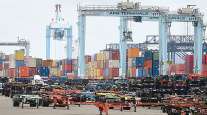DOT Agencies May Revive Truck Survey, Launch New Study Into Causes of Crashes
This story appears in the March 3 print edition of Transport Topics.
Federal government officials said they may revive the Vehicle Inventory and Use Survey and also undertake a new study of the causes of truck crashes.
The moves drew praise from transportation researchers, who said it could be a turning point in efforts to expand collection of truck data after seeing a number of programs cut because of budget constraints.
Federal Highway Administration spokeswoman Nancy Singer confirmed to Transport Topics the agency is looking into the possibility of restarting the Vehicle Inventory and Use Survey, which was last completed in 2002.
“We are in the very early stages of examining the feasibility and do not yet have a sense of timing, scope or funding if it were to be re-established,” Singer said.
“We do recognize that the information provided by the survey is of use to a variety of public and private stakeholders, and the current version is over a decade old,” she added.
Meanwhile, Duane DeBruyne, a spokesman for the Federal Motor Carrier Safety Administration, said last week the agency “anticipates” initiating a second Large Truck Crash Causation Study later this year.
The first study, which examined a sampling of 967 fatal crashes from 2001 to 2003, found that drivers, rather than equipment or weather, were the main reasons for crashes. The results were released in 2006 and have been used as a basis for significant regulatory and enforcement changes in recent years.
A new crash study could last 24 months, DeBruyne said.
“We’re excited about the possibility of new data streams,” said Dan Blower, associate research scientist at University of Michigan Transportation Research Institute in Ann Arbor.
Blower said current data on fatal crashes lack sufficient detail on truck size and weight to help formulate effective countermeasures and to direct enforcement efforts where they will do the most good.
“The problem is the dearth of exposure data,” Blower said. “VIUS provided that data, along with the patterns of use for heavy- and medium-duty trucks.”
The Vehicle Inventory and Use Survey was conducted every five years as part of a broader economic census and provided data of the number and type of trucks in the United States.
In 2012, FMCSA withdrew funding for a program at UMTRI called Trucks Involved in Fatal Accidents and Buses Involved in Fatal Accidents (TIFA/BIFA) in which researchers investigated crashes to ascertain details about the vehicles involved and the condition of the drivers involved.
More recently, FMCSA eliminated the requirement for interstate motor carriers to file financial and operating reports.
Blower said it is important to maintain a steady stream of data from a constantly changing industry.
“If we’re serious about improving truck safety, we have to recognize the dynamic nature of industry,” Blower said. “With 3,500 to 4,000 deaths a year, it is certainly within our capability to do something.”
Don Osterberg, senior vice president at Schneider in Green Bay, Wis., said having “more robust” data will help companies choose the most effective safety technologies for their vehicles and allow for more precise calculations of the economic effects of changes in laws and regulations, such as proposals to increase truck size and weight limits and set new fuel-efficiency standards.
“I’m very supportive,” Osterberg said of efforts to revive VIUS. He also would like to see vehicle tele-matics used in future surveys to collect data from more trucks.
Dan Murray, vice president of research for the American Transportation Research Institute, said, while he supports efforts by FMCSA to conduct a new crash causation study, “it is not a good replacement for TIFA or other lost commercial motor vehicle databases.”
Steve Burks, associate professor of economics at the University of Minnesota at Morris, said he agrees the new crash study “is a complement” to other data sources such as TIFA.
“We need the ability to see trends over time and to have deep periodic benchmarks that allow us to see what is happening to the whole industry,” Burks said. “The correct metaphor is a three-legged stool, and the Large Truck Crash Causation Study is only one of the needed legs.”
Burks is also chairman of the Trucking Industry Research Committee at the Transportation Research Board.
Michael Belzer, an associate professor at Wayne State University and a member of the government panel that oversaw the original Large Truck Crash Causation Study, said the process was affected by “politics,” and much of the information collected was “completely irrelevant to truck-crash causation.”
“The sampling system was already 30 years old and completely invalid at the time of the study,” Belzer said.
“If they want to do it again, they ought to bring people like us back into the process earlier in the planning stage,” said Belzer, who later received funding from FMCSA to study economic issues involved in truck crashes.




